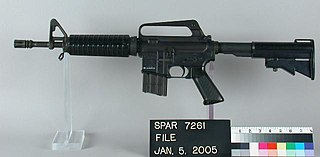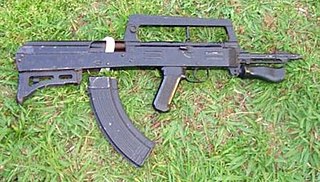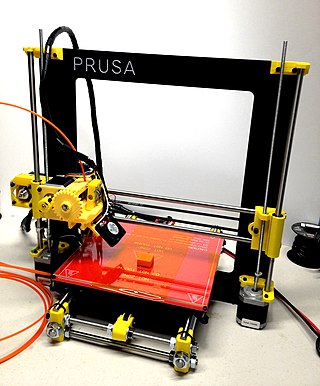
The SA80 is a British family of 5.56×45mm NATO service weapons used by the British Army. The L85 Rifle variant has been the standard issue service rifle of the British Armed Forces since 1987, replacing the L1A1 Self-Loading Rifle. The prototypes were created in 1976, with production of the A1 variant starting in 1985 and ending in 1994. The A2 variant came to be as the result of a significant upgrade in the early 2000s by Heckler & Koch and remains in service as of 2024. The A3 variant was first issued in 2018 with several new improvements.

The Colt AR-15 is a product line of magazine-fed, gas-operated, autoloading rifle manufactured by Colt's Manufacturing Company ("Colt") in many configurations. The rifle is a derivative of its predecessor, the lightweight ArmaLite AR-15, an automatic rifle designed by Eugene Stoner and other engineers at ArmaLite in 1956.

In firearms terminology and law, the firearm frame or receiver is the part of a firearm which integrates other components by providing housing for internal action components such as the hammer, bolt or breechblock, firing pin and extractor, and has threaded interfaces for externally attaching ("receiving") components such as the barrel, stock, trigger mechanism and iron/optical sights. Some firearm designs, such as the AR-15 platform, feature receivers that have 2 separate sub-assemblies called the upper receiver which houses the barrel/trunnion, bolt components etc and the lower receiver that holds the fire control group, pistol grip, selector, stock etc.

The Colt Automatic Rifle-15 or CAR-15 is a family of M16 rifle–based firearms marketed by Colt in the 1960s and early 1970s. However, the term "CAR-15" is most commonly associated with the Colt Commando ; these select-fire carbines have ultrashort 10.5-inch (270 mm) and 11.5-inch (290 mm) barrels with over-sized flash suppressors.
The ArmaLite AR-18 is a gas-operated rifle chambered for 5.56×45mm NATO ammunition. The AR-18 was designed at ArmaLite in California by Arthur Miller, Eugene Stoner, George Sullivan, and Charles Dorchester in 1963 as an alternative to the Colt AR-15 design, a variant of which had just been selected by the U.S. military as the M16. A semi-automatic version known as the AR-180 was later produced for the civilian market. While the AR-18 was never adopted as the standard service rifle of any nation, its production license was sold to companies in Japan and the United Kingdom, and it is said to have influenced many later weapons such as the British SA80, the Singaporean SAR-80 and SR-88, the Belgian FN F2000, the Japanese Howa Type 89 and the German Heckler and Koch G36.

3D printing, or additive manufacturing, is the construction of a three-dimensional object from a CAD model or a digital 3D model. It can be done in a variety of processes in which material is deposited, joined or solidified under computer control, with the material being added together, typically layer by layer.

RepRap is a project to develop low-cost 3D printers that can print most of their own components. As open designs, all of the designs produced by the project are released under a free software license, the GNU General Public License.
The LAPA FA-03 was a bullpup assault rifle designed in Brazil by the company LAPA, and developed by its owner, Nelmo Suzano (1930-2013). The acronym FA-03 stands for "Fuzil de Assalto Modelo 03".

The Norinco Type 86S is an AKM-type bullpup rifle that was produced by Norinco. Many major parts are interchangeable with other standard Kalashnikov rifles.

The Colt CM901 is a modular selective-fire rifle. Its caliber and barrel length can be changed without the use of tools. Its semi-automatic variant is the LE901-16S.

Defense Distributed is an online, open-source hardware and software organization that develops digital schematics of firearms in CAD files, or "wiki weapons", that may be downloaded from the Internet and used in 3D printing or CNC milling applications. Among the organization's goals is to develop and freely publish firearms-related design schematics that can be downloaded and reproduced by anyone with a 3D printer or milling machine, facilitating the popular production of homemade firearms.

An AR-15–style rifle is a lightweight semi-automatic rifle based on or similar to the Colt AR-15 design. The Colt model removed the selective fire feature of its predecessor, the original ArmaLite AR-15, which is a scaled-down derivative of the AR-10 design. It is closely related to the military M16 rifle.

The DEFCAD Charon is an open source 3D-printable AR-15 lower receiver project that was partially inspired by the Fabrique Nationale P90. It began as a design exercise by a DEFCAD user to explore FDM additive manufacturing technology as a means of integrating the P90's ergonomics into a stock for the AR-15, resulting in the WarFairy P-15 stock set.

A 3D-printed firearm is a firearm that is partially or primarily produced with a 3D printer. While plastic printed firearms are associated with improvised firearms, or the politics of gun control, digitally-produced metal firearms are more associated with commercial manufacturing or experiments in traditional firearms design.
The G22 Grizzly is a series of 3D-printed, single-shot, break-action rifles that fire .22LR cartridges. Initially developed in 2013 by a Canadian designer known by the pseudonym "Matthew", the G22 Grizzly has evolved through multiple iterations, with each version improving design, functionality, and printability. It is known for its high level of 3D-printability, requiring minimal non-printable metal parts. The latest version, G22v4, was released in September 2023.
The Cuomo Mag is a 3D printed AR-15 magazine named after the Governor of New York, Andrew Cuomo, who signed the NY SAFE Act into law banning magazines capable of holding more than 10 rounds of ammunition. It was created by Defense Distributed and made public around January 2013
The WarFairy P-15 is a 3D printed Fabrique Nationale P90 stock made public around May 2013. It was printed using a LulzBot Taz printer via the fused deposition modeling (FDM) method. It was created by WarFairy

Fused filament fabrication (FFF), also known as fused deposition modeling, or filament freeform fabrication, is a 3D printing process that uses a continuous filament of a thermoplastic material. Filament is fed from a large spool through a moving, heated printer extruder head, and is deposited on the growing work. The print head is moved under computer control to define the printed shape. Usually the head moves in two dimensions to deposit one horizontal plane, or layer, at a time; the work or the print head is then moved vertically by a small amount to begin a new layer. The speed of the extruder head may also be controlled to stop and start deposition and form an interrupted plane without stringing or dribbling between sections. "Fused filament fabrication" was coined by the members of the RepRap project to give an acronym (FFF) that would be legally unconstrained in its use.

In recent years, 3D printing has developed significantly and can now perform crucial roles in many applications, with the most common applications being manufacturing, medicine, architecture, custom art and design, and can vary from fully functional to purely aesthetic applications.













